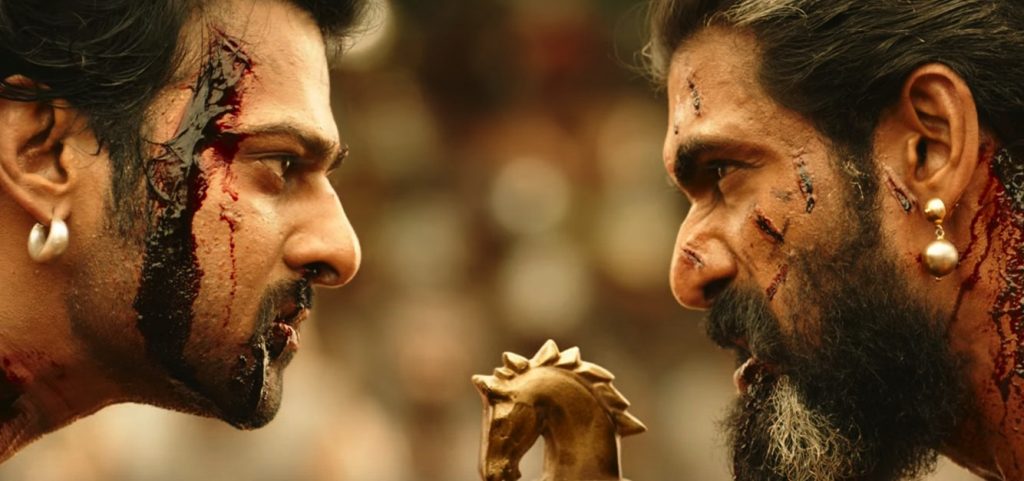Sometimes, you have to begin at the end. When the final credits of Baahubali 2: The Conclusion roll, it goes on for almost eight minutes, until the entire theater is empty. I especially love the fact that director SS Rajamouli makes sure he acknowledges the ‘shoemakers’ too. Any enterprise with so many people’s creativity involved inevitably rises above the ordinary. And the movie does manage to stay sterling almost throughout its 171-minute running time.
The first five minutes of Baahubali 2: The Conclusion are little more than ‘dead air’ with hundreds of brand names appearing under various heads such as snack partner, mobile partner, gaming partner etc. making a rather strong comment about new-age branding in films today. At last the movie begins with Rajmata Sivagami Devi (Ramya Krishna), the matriarch of the Mahishmathi kingdom, taking up the arduous ‘Rakshasa Dahanam’, a family ritual that ensures the safety of the kingdom from evil forces. We are introduced to the valor of Prince Amarendra Baahubali (Prabhas) in ensuring that the ritual goes on without hindrance despite a mad elephant on the run. The Queen then announces the date for the coronation of Baahubali as the king while anointing her own son Bhallaladeva (Rana Daggubati) as the army chief, much to his chagrin. She advises Baahu to first tour the kingdom to understand the travails of his subjects. It is here that he meets the beautiful and hotheaded Devasena (Anushka), a valiant warrior princess who knows no fear and is ready to challenge stereotypes. He promises to wed her, but soon enough Bhalladeva gets to know of his cousin’s love story and wants to kill three birds with one stone…. And so the intrigues begin.
Director Rajamouli places emotions on a high pedestal throughout the movie. The plot is rich in royal intrigue, vendetta, clever strategy, high voltage drama and hyper emotions. For instance, when Sivagami thinks about issues affecting the kingdom, her dilated pupils set in kohl-lined eyes and her flaring nostrils fill the entire screen to bring out her anguish. When Baahu has to fight, he showers the arrows in groups of three and when he kills, he does so in pairs with the dagger piercing through two people in sync. As always, the director’s favorite elements of bleeding torsos, the resonating sound from clashing weapons engulfing the entire surround sound system as the screen freezes for a split second and blood oozes out in ultra slow motion, are all there in large measures. But above all, Rajamouli thankfully portrays his women as powerful and intelligent, a big rarity in our mainstream cinema, and I have to give him extra brownie points just for that.
Prabhas will go down Indian cinema history as the actor who perhaps looks most dashing as a king. His act is exemplary too. From his expressions to his understated dialogue delivery, he just aces it. Rana is a good match opposite him and looks quite the suitable brand ambassador for deceit and treachery. With his wounded tiger looks, he excels in the climax. While her performance is fine, Anushka’s weight seems to yo-yo throughout the movie and her relatively small screen time and a minimal dosage of glamor (even as the princess) might end up disappointing some of her fans. The real heroes, however, are Ramya Krishna and the super wicked Bejjala Dev, played perfectly by Nasser, who looks like Shakuni with a Chinese mustache.
Technically, the film is a standout as expected. Senthil Kumar’s stunning visuals are magnum-opus like in every sense perfectly complementing the jaw-dropping production design of the film. For Rajamouli, even a ship is never just a ship. It has to be a fancy swan that glides through waters and transforms into a butterfly mid-water. Using palm trees to transport water and later on as catapults to launch soldiers into the fort was a masterstroke. The war scene though is confusing as you wonder who is after whom, sometimes pulling you out of the fight. But since it is a battle, I suppose one must except some chaos and not necessarily perfect order. While the VFX is undoubtedly first-rate, those of us used to constantly playing mobile games do manage to differentiate between graphics and real actors. As for the music, the title song and the Mahishmati anthem stand out and are a strong testimony to Keeravani’s capabilities. His background score is slick too heightening the emotions at several places. However, the long running screen time makes you feel just that bit restless at times. The film should have ideally ended ten minutes after Baahu and Bhalala confront each other. But Rajamouli decides to add another 25 minutes of one-on-one action between the two warriors to try and build up to a satisfying and cathartic climax.
Overall, this two-part, five-year labor of love for SS Rajamouli will be deservedly remembered in the history of Indian cinema as a stupendous achievement. Go watch it for sure, but not necessarily at the cost of three times the ticket money, which is unfair. And as for the answer to that eternal question of why did Kattappa kill Baahubali, just see the film will you?!
Telugu, Fantasy, Action, Drama


